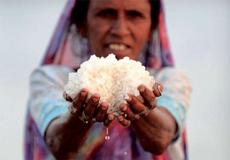Salt iodization works
The world's population has never been so well supplied with iodine as today. Major progress in salt iodization is evident in a new global study in school children done by nutrition researchers at the ETH Zurich. But there is still room for improvement of the situation in Africa and South East Asia.

Iodine deficiency causes goiter (swelling of the neck) and impairs mental development, but these health problems are being eliminated by iodized salt in many countries. According to a new study, the population in 105 countries is consuming enough iodine - and goiter and mental retardation due to iodine deficiency is hence not a general public health problem anymore. The WHO showed in 2003 that the population of 67 countries consumed sufficient iodine from the diet. Between 2003 and 2011 the number of countries with iodine deficiency decreased from 54 countries to 32.
Switzerland is one of the 105 countries worldwide where the overall population is getting enough iodine. This is shown in studies done by the ETH researchers and is confirmed by the Swiss Federal Office of Public Health (BAG). The exceptions are infants and lactating women two population groups which have borderline low intakes. In their present study, the ETH researchers evaluated iodine data from 148 countries and compared them with investigations done by WHO in 2003 and 2007.
One of three pupils needs more
The study was conducted by Michael Zimmermann and Maria Andersson, from the ETH Laboratory of Human Nutrition, in collaboration with the International Council for the Control of Iodine Deficiency Disorders (ICCIDD) and the World Health Organization (WHO). The results show that every third school child worldwide still has insufficient iodine intake, particularly in South East Asia and Africa. In these regions 76 million and 58 million children get too little iodine from their diets, respectively.
In some countries, salt iodization programs have slipped backwards. In Russia, for example, the dietary iodine intake considerably decreased after the collapse of the Soviet Union, and the Russian population now has too low iodine intakes. A similar trend is seen in other industrialized countries, e.g. Australia, New Zealand and the United Kingdom, where the iodine intake earlier was assumed to be adequate, but where the population now is iodine deficient.
“Iodization of salt is not regulated in the legislation in the United Kingdom”, says Maria Andersson, co-author of the study. Only about five percent of the salt sold in the United Kingdom is iodized. But, the iodine intake may be insufficient also in countries that actually do have an appropriate legislation. “The young people are becoming increasingly skeptical about food additives and people may not know why it is important to choose iodized salt”, says the researcher.
Switzerland has been, and still is, considered a model country when it comes to the iodization of edible salt. In 1918 a Swiss physician showed that consumption of salt with added iodine was effective in reducing goiter. At that time, 3 out of 4 people had goiter in some of the mountain villages. Switzerland started to add iodine to salt already in 1922. The iodine level was gradually increased over the years. The level of iodine in the Swiss iodized table salt is currently 20 mg per kg.
Salt works satisfactory
“Salt is a good universal food vehicle for iodine”, stresses Maria Andersson. There are now only a few areas in the world where iodized salt is not available. The addition of iodine to salt is cheap and costs between 2 and 5 US cents per person per year. Salt is a basic food item that most people can afford. A recent UNICEF report shows that iodized salt is available in more than 120 countries worldwide and that 70% of the world’s population now has access.
“In industrialized countries the challenge is not mainly access to iodized salt, but to make the food industry to use iodized salt in the food production”, says Andersson. Iodine is indeed one of the essential trace elements which are difficult to get in large enough quantities from the food. Yet the level of iodine in the salt must still be controlled to make sure that people do not get ‘too much of the good thing’. The study by the ETH researchers also shows that the iodine intake from salt can be too high, as seen in 11 countries, e.g. Uganda.
Iodine
Iodine naturally
occurs in sea water and in the soil. Sea fish and algae are thus rich sources
of iodine. Other important food sources are bread and milk. However, the total
amount of iodine from the overall diet foods is generally not enough to meet
the physiological iodine requirements.
Iodine deficiency
was historically a problem in mountain regions as iodine from the soil has been
washed out over thousands of years. Plants grown in areas with low iodine content
do not take up enough iodine, and too little iodine is incorporated into the
food chain. Iodine deficiency is not only causing goiter. Iodine deficiency
harms the brain development. The consequences are reduced cognitive abilities,
lower IQ and impaired motor function. Iodine is particularly important for
neonatal and infant development. Pregnant and lactating women have higher
iodine requirements to meet the need of the growing fetus and infant.
Iodine is a
natural constituent of the thyroid hormones. These are important for a normal brain
development of neonates and young children. Thyroid hormones control human
metabolism and important body functions as temperature regulation.
Iodine can easily
be measured in the urine. The concentration of iodine in urine samples
collected from a group of people can tell the scientists if the population is
iodine deficient or not.
Reference
Andersson M, Karumbunathan V, Zimmermann MB, Global Iodine Status in 2011 and Trends over the Past Decade. J. Nutr. 142: 1–7, 2012, published online February 29, 2012, doi:10.3945/jn.111.149393
- 12.04.12: Lebenswichtiges Iod: Ist Iod wirklich für alle gut?
- 05.03.12: Stellungnahme zur ETH-Studie über Jod
- 01.03.12: Iodierung: Besser informieren!








READER COMMENTS